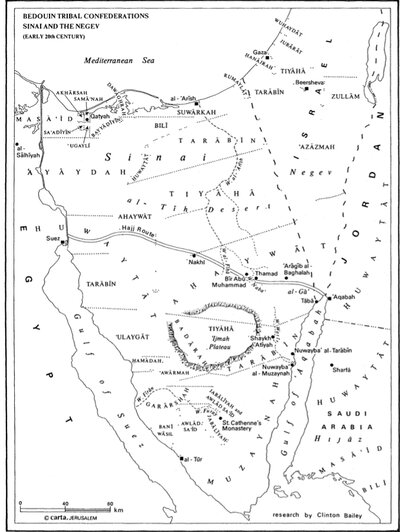
Meirav Malter
Global Studies Program, College of Liberal Arts and Sciences, University of Illinois at Urbana-Champaign
Global Studies Program, College of Liberal Arts and Sciences, University of Illinois at Urbana-Champaign

Rates of insurgency and terrorism are currently rising on a global scale. Today there is a violent insurgency in the Sinai Peninsula between the Egyptian military and Salafi-jihadist (Islamist) militants, with the local Bedouin tribal population caught in between. The Sinai and its Bedouin tribes have a long history of military occupation and administration by foreign governments, in part because of the Sinai’s strategic location between Asia and Africa.
Throughout the turbulent history of military and government occupations of the Sinai Peninsula, the local Bedouin have continued to live in the territory. The Bedouin are a semi-nomadic population closely related to the Bedouin living in the Negev Desert that is part of modern-day Israel. Before formal state boundaries existed, these Bedouin populations migrated from the Arabian Peninsula to the Sinai and moved freely throughout the region. Since the mid-20th century, these groups have diverged and their experiences in the nation-state system have been vastly different.
Have the multiple changes in administration of the Sinai and its Bedouin population increased the likelihood of insurgency in the territory? Is it possible to compare the Sinai Peninsula with its historic changes of Israeli and Egyptian administration of the Bedouin population, to the continuous Israeli administration of the neighboring Bedouin population in the Negev Desert in the period of 1967 to 2017.
I hypothesize that multiple changes of administration over a given territory will produce inconsistent economic, social, and political conditions for the territory and local population, and as a result there will be greater chance of insurgency. I expect that through a comparative analysis of the case of the Sinai and its Bedouin population and the case of the Negev and its Bedouin population, I can identify Israel and Egypt’s different administrative practices. In addition, this comparison will likely determine which factors have contributed to the outcome of insurgency in the Sinai and that of stability in the Negev that we see today.

“A protracted politico-military struggle designed to weaken the control and legitimacy of an established government, a military occupation government, an interim civil administration, or a peace process while increasing insurgent control and legitimacy – the central issue in an insurgency.”1
The rising tensions in the Sinai in recent years have been attributed to the growing number of insurgents in the territory and their agenda to replicate the actions of the Islamic State from Iraq and Syria in the Sinai. The recent insurgency Northern Sinai requires military and humanitarian responses from the Egyptian government.
Bedouin of the Sinai identify themselves as pastoral nomads, although they have “departed from otherwise typical practice of defining territorial dominance through access to pastures.”2
Bedouin most commonly operate within the wage labor or migrant labor economy. They often maintain small flocks, herds, or palm orchards in desert oases, as an economic means to fall back on, but for decades they have relied on the occupying state to provide labor opportunities.3
This means that the governing responsibilities over a given territory are assumed by a new ruling power due to the outcome of war or diplomatic negotiations.
The map above shows Bedouin tribal confederacies of both the Sinai and the Negev in the early-20th century.4
This study employs qualitative methods to investigate the research question.
Both historical methods of data collection and qualitative comparative analysis based on political science research methods are implemented in the research process.
This study reviews the existing social science literature on insurgency and civil war to understand the fundamental differences between these two modes of warfare.
Characteristics of insurgency explained in the literature suggests that insurgency is the type of conflict that currently exists in the Sinai Peninsula.
Historical maps, government documents, and scholarly literature show that the Sinai and the Negev are comparable territories with related populations.
Examining and recording the differences in Israeli and Egyptian administration of the Sinai from 1967 to 2017, provides data that can be compared to the information collected on the continuous Israeli administration of the Negev.
Thus, the recorded economic, social, and political responses of the Bedouin population in each territory to the government policies of each administration, can be understood as the mechanisms that are potentially linked to the breakout of insurgency.
This study uses scholarly literature and government documents as its main source of data and analysis.



Insurgency is currently present in the Sinai.
The Sinai and Negev are comparable due to several reasons found in the research..
“When discussing the Bedouin of the Negev, one must always bear in mind the geographical contiguity of the Negev and the Sinai… a very large part of the cultural heritage of the Negev Bedouin must have been formed during the sojourn in Sinai.”5
Israel acquired the Sinai during the Six Day War in 1967 and it is possible to compare the administration of the Bedouin in both territories under Israel from that period forward.
Due to changes of administration, the Sinai Bedouin have experienced economic, social, and political inconsistencies, whereas the Negev Bedouin have not.
In the case of the Sinai Peninsula, insurgency appears to be an outcome of multiple changes in government administration that the Sinai and its Bedouin population experienced since the mid-20th century. This situation suggests a failure of the government policies implemented by both Israel and Egypt since 1967, and now requires alternative government policies to restore stability and development.
Thank you to my project committee members Dr. Kenneth Cuno and Dr. Avital Livny for their guidance and advice during this project. As this is an interdisciplinary work, I have appreciated learning about both the historical and political science research methods, as well as how to balance my study between these two disciplines.

125 Coble Hall
801 S. Wright Street
Champaign, IL 61820
Email: globalstudies@illinois.edu